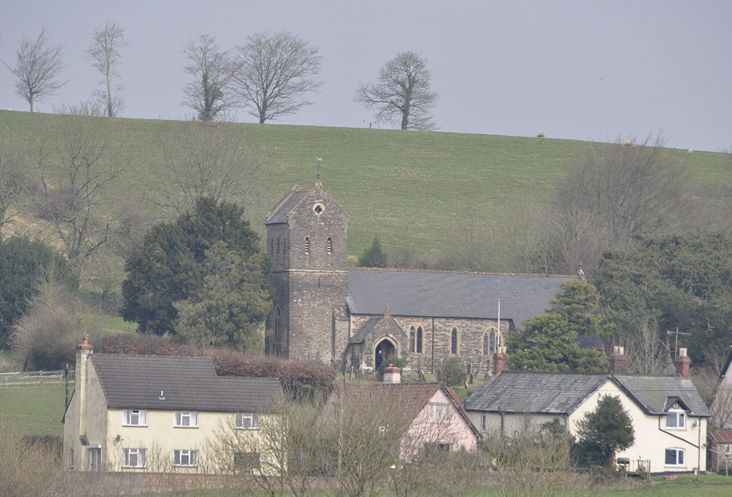 |
| Morebath Church, photo by Lewis Clarke (CC BY-SA 2.0). The church and tower will have been familiar to the people described, but of course the objects within have long since disappeared . |
Eamon Duffy’s The Voices of Morebath (2001) is a real
gem. Using the remarkable survival of parish records for one small Devonshire
village of 33 households, Duffy provides a history of the English Reformation,
but not from the top, but this time from
below. In this book, we are down to counting individual sheep and altar
cloths. The local saint, St Sidwell, plays a major role, before being written
entirely out of the script by the end. The records exist for the 54 years when
the priest, Sir (the title is apparently traditional for a priest at the time)
Christopher Trychay (pronounced “tricky”) was vicar of the parish.
Duffy is a Catholic, and for much of the book, it reads like
a lament for a local community that was surprising for the extent of social
activity and generosity. The author himself describes the book as exploring “the
world-view which was the religion of most English people on the eve of the
Reformation, and impact of radical religious change on the majority who would
have liked things to stay more or less as they were.” The parish records record the existence not
just of the church wardens, roles that still exist today, but as many as six
separate groups of parishioners, some of the men, and some women’s groups, all
raising funds and carrying out activities for the community, but primarily to embellish
the church fabric and altars. Reading it, I kept thinking of two comparisons.
First, obviously, comparing tiny Morebath to present-day local groups here in
the centre of Cambridge: the local residents’ association, and local politics,
and the extent to which residents combine (or don’t) for some collective action.
Like many historians, Duffy presents before us an image of a kind of golden age,
partly created through the exceptional vicar, who captured so much of the life
of the village.
Second, there is the obvious contrast between Catholic and Protestant England. The transition was very messy, with interludes (under Edward and Mary) of undoing everything that had been done by their predecessors. What makes this book exceptional is the questions it raises. To his credit, Duffy at the end moves slightly away from the simplistic vision of a local Catholic golden age , but in so doing, leaves this reader dissatisfied with the sudden reversion to the big picture. After chapters full of painstakingly documented evidence of how the village was happy to remain worshipping saints (including St Sidwell) and keeping candles burning for them, we suddenly shift to grand statements such as “a sign of the deepening gap between rich and poor which marked and darkened the hungry later years of Elizabeth”. With that sentence, the spell is broken; we want evidence, we are no longer satisfied with such wide-scale assertions. There are disturbing mentions of the introduction of a “cucking stool” late in the period, for the punishment of women, and a reference to historians who feel it indicated something wrong in the social order.
And, indeed, this book makes you start to think about the astonishing changes during 16th-century England. In 1500, church building and church adornment was still part of every town and village activity. But at some point in the 16th century, church building in England more or less came to a halt. It wasn’t just the abolition of chantries and saints’ altars, it was a complete cessation of new sacred architecture (the only exception was tombs for the rich, something not mentioned by Duffy, probably because it doesn’t appear that the church of Morebath ever had any such grand tombs).
For any history book to inspire the reader to see a moment
of vast societal change is a great achievement. I can hardly complain if Duffy
leaves me in the end unsatisfied, because I can’t help feeling there is more to
the story than he reveals. The book raises so many questions! At the start of
this book, this tiny village was dedicating a large portion of its surplus revenue
to adorning the church building. By the end of the 16th century, condemnation
of “popery” was universal and popular. How did popular opinion move so
dramatically away from Catholicism? I don’t mean the major beliefs, but the
seemingly abrupt change in popular feeling. And how could an entire population switch
so dramatically from building and adornment for faith, to the feeling that
plain walls and lack of decoration were somehow better? And how could the
priest switch so decisively from promoting Catholicism to the latest version of
orthodox Protestantism? It was the same vicar, before, during, and after the
events. Duffy talks about the secularisation of the church accounts, but leaves
me wanting much more. Sentences such as this leave me gasping for more
information:
The process of secularisation of
the parish was more than all this: it was in train before the break with Rome …
it owes as much to the extension of strong government, and the multiplication of responsibility within local
community, as to any ideological shift. [p282]
That seems at odds with everything Christopher Trychay
describes in his records, a diminishing, rather than growth, of local
community.
The Reformation was clearly an enormous turning point for
modern society, and is of course something that can not be explained in any
single book. Perhaps the very fact that I want to know more, that I have so
many other questions at the end when Sir Christopher dies, is a tribute to this
fascinating book.



No comments:
Post a Comment